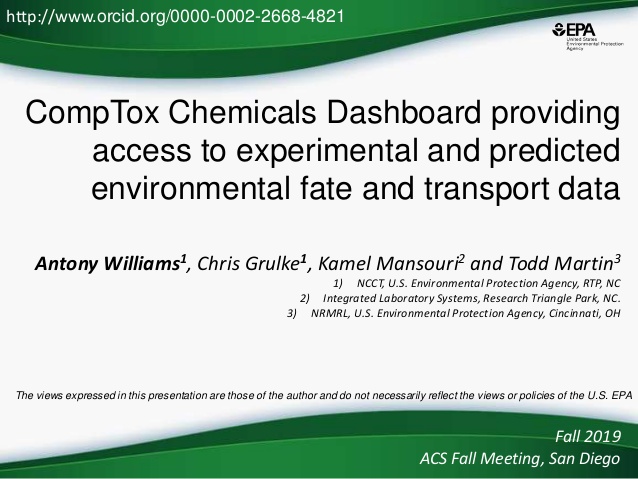-
Be the first to like this
-
The AI Rush by Jean-Baptiste Dumont 2332744 views
-
AI and Machine Learning Demystified... by Carol Smith 4059922 views
-
10 facts about jobs in the future by Pew Research Cent... 1067573 views
-
Harry Surden - Artificial Intellige... by Harry Surden 872523 views
-
Inside Google's Numbers in 2017 by Rand Fishkin 1456457 views
-
Pinot: Realtime Distributed OLAP da... by Kishore Gopalakri... 701047 views
US-EPA CompTox Chemicals Dashboard providing access to experimental and predicted environmental fate and transport data
Published on
Access to both experimental and predicted environmental fate and transport data is facilitated by the US-EPA CompTox Chemicals Dashboard. Providing access to various types of data associated with ~900,000 chemical substances, the dashboard is a web-based application supporting computational toxicology research in environmental chemistry. When experimental physicochemical and fate and transport data are not available, QSAR models developed using curated datasets are used for the prediction of properties. These include: bioaccumulation factors, bioconcentration factors, and biodegradation and fish biotransformation half-lives. For chemicals of interest that are not already registered in the dashboard real-time predictions based on structural inputs are available. This presentation will provide an overview of the dashboard with a focus on the availability of environmental fate and transport data, access to real time predictions, and our ongoing efforts to harvest and curate available experimental data from the literature and online databases. This abstract does not necessarily represent the views or policies of the U.S. Environmental Protection Agency.
US-EPA CompTox Chemicals Dashboard providing access to experimental and predicted environmental fate and transport data
- 1. CompTox Chemicals Dashboard providing access to experimental and predicted environmental fate and transport data Antony Williams1, Chris Grulke1, Kamel Mansouri2 and Todd Martin3 1) NCCT, U.S. Environmental Protection Agency, RTP, NC 2) Integrated Laboratory Systems, Research Triangle Park, NC. 3) NRMRL, U.S. Environmental Protection Agency, Cincinnati, OH Fall 2019 ACS Fall Meeting, San Diego http://www.orcid.org/0000-0002-2668-4821 The views expressed in this presentation are those of the author and do not necessarily reflect the views or policies of the U.S. EPA
- 2. Overview • The CompTox Chemicals Dashboard - web- based database of 875k substances • Associated data including: – In vivo hazard data – In vitro bioactivity screening data – Link farm to tens of public resources • Includes experimental and predicted physchem and experimental fate and transport data • Access to real-time predictions • A quick overview of capabilities… 1
- 3. CompTox Chemicals Dashboard https://comptox.epa.gov/dashboard 2
- 4. BASIC Search 3
- 5. Detailed Chemical Pages 4
- 6. Experimental and Predicted Data 5
- 7. Prediction models and transparency 6
- 8. Curated data 7
- 9. Public PHYSPROP Dataset 8
- 10. LogP dataset: 15,809 structures • CAS Checksum: 12163 valid, 3646 invalid (>23%) • Invalid names: 555 • Invalid SMILES 133 • Valence errors: 322 Molfile, 3782 SMILES (>24%) • Duplicates check: –31 DUPLICATE MOLFILES –626 DUPLICATE SMILES –531 DUPLICATE NAMES • SMILES vs. Molfiles (structure check) –1279 differ in stereochemistry (~8%) –362 “Covalent Halogens” –191 differ as tautomers –436 are different compounds (~3%) 9
- 11. OPERA Predicted Properties 10 OPERA Models: https://github.com/kmansouri/OPERA
- 12. OPERA Standalone Application 11
- 13. Open Source https://github.com/kmansouri/OPERA 12
- 14. Environmental Fate and Transport 13
- 15. Environmental Fate and Transport 14
- 16. ECOTOX data 15
- 17. Other prediction modules TEST Desktop Software 16
- 18. Real-Time Predictions Based on TEST 17
- 19. Real-Time Predictions 18
- 20. TEST Predictions Detailed calculation reports 19
- 21. TEST Predictions Detailed calculation reports 20
- 22. Built on TEST Web Services https://www.epa.gov/sites/production/files/2018-08/documents/ webtest_users_guide.pdf 21
- 23. Batch Searching • Given a set of chemicals how can data be harvested? • OPERA and TEST predictions have been generated for structures in the database • How can the dashboard be used to harvest data for hundreds to thousands of chemicals… 22
- 24. Example list of chemicals - Opioids 23
- 25. Batch Search Names 24 Excel Download
- 26. Include Other Data of Interest 25
- 27. Batch search results - SDF 26
- 28. Work in Progress 27
- 29. Prototype Development Structure/substructure search 28
- 30. OPERA pKa Prediction Model • pKa prediction models based on Open Data Set of 8000 chemicals – acidic, basic and amphoteric chemicals • Accepted for publication to Journal of Cheminformatics29
- 31. “Chemical Transformation Simulator” • Chemical Transformation Simulator has public web services already available – (1) Abiotic Hydrolysis – (2) Abiotic Reduction – (3) Phase 1 Metabolism 30 Mock-up
- 32. Ongoing Extraction of Data • Data are extracted from literature based on agency priorities • Specific data sets of interest at present include those available for PFAS chemicals • Data releases are every 6 months at present 31
- 33. Conclusion • Dashboard access to data for ~875,000 chemicals • Ongoing aggregation of physicochemical property and environmental fate and transport data 32 • Retraining and rebuilding of models will occur as new data are assembled • Web services already available for TEST predictions with services for OPERA next • Future developments include integration of chemical transformation simulator
- 34. Acknowledgements EPA-RTP • An enormous team of contributors from NCCT, especially the IT software development team and data curation team • US-EPA ECOTOX for sharing data from their database • Valery Tkachenko for development of TEST web services
- 35. Contact Antony Williams NCCT, US EPA Office of Research and Development, Williams.Antony@epa.gov ORCID: https://orcid.org/0000-0002-2668-4821 34 https://doi.org/10.1186/s13321-017-0247-6







Be the first to comment